![]()
Green, pulpy, sweet, and healthy. That is guyabano for you.
Guyabano (Anona muricata), or soursop as it is known in English, is a small tropical fruit tree bearing a sweet heart-shaped fruit with a soft-spined green outer skin and soft pulpy white flesh. It has been refreshing people for a long time as a fruit juice, flavoring, puree, tea, or eaten as it is. It is being widely cultivated in Central America, some sub-Saharan parts of Africa, and in Southeast Asia, the Philippines included.
[caption id="" align="alignnone" width="375"]
![Soursop 015 by I likE plants! soursop photo]() Photo by I likE plants!
Photo by I likE plants! ![]()
[/caption]
But aside from being rich in carbohydrates, dietary fiber, and Vitamins C, B1, and B2, do you know why it is very good for you? Studies by the Chemicals and Energy Division (CED) of the Department of Science and Technology’s Industrial Technology Development Institute (DOST-ITDI) show that guyabano generally has high flavonoid content. Flavonoids are phytochemicals that have been found to inhibit or even prevent the growth of viruses, carcinogens, and allergens.
These are just the few benefits that the DOST-ITDI aims to harness as it develops and promotes guyabano as a natural dietary health supplement. Traditionally,
guyabano has been consumed by diabetics to lower their blood sugar, and tests showed that it even outperforms Metformin, the most commonly used maintenance drug of diabetics, in lowering blood glucose levels.
Hence there is the need for a better and more convenient packaging for
guyabano to strengthen its marketability.
ITDI’s CED, while adhering to WHO standards, processed and packaged
guyabano fruits and leaves into 250 and 300mg capsules or in two-gram teabags. “Thus,
guyabano capsules and tea bags are now more convenient to use. They are standardized and naturally processed, and thus guaranteed safe,” says Annabelle Briones, CED chief science research specialist.
In addition,
guyabano has been scientifically and traditionally proven to have great natural benefits. It helps lower fever, spasms, heart rate, and blood pressure. It also helps relieve pain, inflammation, and asthma. Consuming guyabano extract can also safely prevent cancer cells from forming while effectively slowing down tumor growth. It also helps stop the growth of harmful bacteria, viruses, fungi, and parasites, even as it stimulates digestion and stop convulsions.
At the ITDI, CED researchers performed thin-layer chromatographic fingerprinting and phyto-chemical screening on the
guyabano extract to determine its chemical makeup. They also tested the fruit for anti-microbial capability against Staphylococcus aureus, E. coli, and other common bacteria strains, as well as for acute toxicity.
They used the Folin-Ciocalteau method to determine the antioxidant content of the leaves and fruits. After the screening, the researchers confirmed that the
guyabano extract used was relatively free of pesticide residues, heavy metals, molds, and salmonella.
“We also discovered that the green unripe
guyabano fruit contains more flavonoids than the yellowish ripe fruit. The leaves meanwhile are rich in tannins, fats and oils, unsaturated steroids, and triterpenes, and again, more flavonoids,” Briones said. “Therefore, all these properties really make guyabano an ideal health supplement.”
So it seems like it is not just an apple a day that could keep the doctor away, but
guyabano too!
Written by Reginald Roy U. de la Cruz, S&T Media Service, DOST- ITDI

 Image: kusinanimanang.blogspot.com[/caption]
Bottled Bangus in Corn Oil
(Adapted from Gamboa, 2000 and BFAR-7, 2001)
Ingredients (per 8 oz bottle)
Bangus
Corn oil (To fill)
Carrots 2 slices
Pickles 2 slices
Peppercorn 3 pcs.
Chili pepper (Siling labuyo) 1 pc.
Iodized salt 1/2 tsp.
MSG (pinch)
Bay leaf 1 pc.
Procedure:
1. Remove the head, fins, tail, belly flaps and internal organs.
2. Cut the fish transversely to fit the size of the bottle.
3. Wash the fish thoroughly to remove all traces of blood
4. Partially dehydrate and pre-process fish by either of two ways:
a. Dry for 2 hours under the sun or until firm and deep fry in oil for 2 minutes (Gamboa, 2000)
b. Soak in 10% brine solution (1 part salt to 9 parts of water) for 15-25 minutes depending on the size of the fish (BFAR-7, 2001)
5. Place the fish inside the bottles and add the rest of ingredients.
6. Fill with corn oil, leaving ¼ inch space from top of bottle.
7. Lightly cap bottles and exhaust by putting in a hot water bath or by steaming for 15 to 20 minutes.
8. Cap bottles tightly while still hot and check for leakage by inverting each bottle.
9. Arrange in pressure cooker and process for 100 minutes at 10 psi.
10. Allow pressure to drop. Remove the jars, allow to cool and wash with soap and water.
11. Dry bottles, apply label and plastic cap sealer.
12. Store for at least one month to attain desired flavor before distributing
Source: (Wilfredo G. Yap, Antonio C. Villaluz, Ma. Gracia G. Soriano, and Mary Nia Santos) Milkfish Production and Processing Technologies in the Philippines
Image: kusinanimanang.blogspot.com[/caption]
Bottled Bangus in Corn Oil
(Adapted from Gamboa, 2000 and BFAR-7, 2001)
Ingredients (per 8 oz bottle)
Bangus
Corn oil (To fill)
Carrots 2 slices
Pickles 2 slices
Peppercorn 3 pcs.
Chili pepper (Siling labuyo) 1 pc.
Iodized salt 1/2 tsp.
MSG (pinch)
Bay leaf 1 pc.
Procedure:
1. Remove the head, fins, tail, belly flaps and internal organs.
2. Cut the fish transversely to fit the size of the bottle.
3. Wash the fish thoroughly to remove all traces of blood
4. Partially dehydrate and pre-process fish by either of two ways:
a. Dry for 2 hours under the sun or until firm and deep fry in oil for 2 minutes (Gamboa, 2000)
b. Soak in 10% brine solution (1 part salt to 9 parts of water) for 15-25 minutes depending on the size of the fish (BFAR-7, 2001)
5. Place the fish inside the bottles and add the rest of ingredients.
6. Fill with corn oil, leaving ¼ inch space from top of bottle.
7. Lightly cap bottles and exhaust by putting in a hot water bath or by steaming for 15 to 20 minutes.
8. Cap bottles tightly while still hot and check for leakage by inverting each bottle.
9. Arrange in pressure cooker and process for 100 minutes at 10 psi.
10. Allow pressure to drop. Remove the jars, allow to cool and wash with soap and water.
11. Dry bottles, apply label and plastic cap sealer.
12. Store for at least one month to attain desired flavor before distributing
Source: (Wilfredo G. Yap, Antonio C. Villaluz, Ma. Gracia G. Soriano, and Mary Nia Santos) Milkfish Production and Processing Technologies in the Philippines

 The restaurant chain uses a mesquite grill, so these steps are crucial to getting the same smoky flavor as the addictive restaurant version. Chevys uses chipotle peppers, or smoked red jalapeno peppers. But unless you grow your own jalapenos, it may be difficult to find the riper red variety in your local supermarket. For this recipe, the green jalapeno peppers will work fine.
6 medium tomatoes
10 jalapenos (red is best)
1/4 of a medium Spanish onion
2 cloves garlic
2 tablespoons chopped fresh cilantro
2 tablespoons white vinegar
2 teaspoons salt
1 1/2 teaspoons mesquite-flavored liquid smoke
1. Preheat your barbecue grill to high temperature.
2. Remove any stems from the tomatoes, then rub some oil over each tomato. You can leave the stems on the jalapenos.
3. Place the tomatoes on the grill when it’s hot. After about 10 minutes, place all of the jalapenos onto the grill. In about 10 minutes you can turn the tomatoes and the peppers. When almost the entire surface of the peppers has charred black you can remove them from the grill. The tomatoes will turn partially black, but when the skin begins to come off they are done. Put the peppers and tomatoes on a plate and let them cool.
4. When the tomatoes and peppers have cooled, remove most of the skin from the tomatoes and place them into a food processor. Pinch the stem end from each of the peppers and place them into the food processor as well. Toss out the liquid that remains on the plate.
5. Add the remaining ingredients to the food processor and puree on high speed for 5-10 seconds or until the mixture has a smooth consistency.
6. Place the salsa into a covered container and chill for several hours or overnight while the flavors develop.
Makes approximately 2 cups.
The restaurant chain uses a mesquite grill, so these steps are crucial to getting the same smoky flavor as the addictive restaurant version. Chevys uses chipotle peppers, or smoked red jalapeno peppers. But unless you grow your own jalapenos, it may be difficult to find the riper red variety in your local supermarket. For this recipe, the green jalapeno peppers will work fine.
6 medium tomatoes
10 jalapenos (red is best)
1/4 of a medium Spanish onion
2 cloves garlic
2 tablespoons chopped fresh cilantro
2 tablespoons white vinegar
2 teaspoons salt
1 1/2 teaspoons mesquite-flavored liquid smoke
1. Preheat your barbecue grill to high temperature.
2. Remove any stems from the tomatoes, then rub some oil over each tomato. You can leave the stems on the jalapenos.
3. Place the tomatoes on the grill when it’s hot. After about 10 minutes, place all of the jalapenos onto the grill. In about 10 minutes you can turn the tomatoes and the peppers. When almost the entire surface of the peppers has charred black you can remove them from the grill. The tomatoes will turn partially black, but when the skin begins to come off they are done. Put the peppers and tomatoes on a plate and let them cool.
4. When the tomatoes and peppers have cooled, remove most of the skin from the tomatoes and place them into a food processor. Pinch the stem end from each of the peppers and place them into the food processor as well. Toss out the liquid that remains on the plate.
5. Add the remaining ingredients to the food processor and puree on high speed for 5-10 seconds or until the mixture has a smooth consistency.
6. Place the salsa into a covered container and chill for several hours or overnight while the flavors develop.
Makes approximately 2 cups.

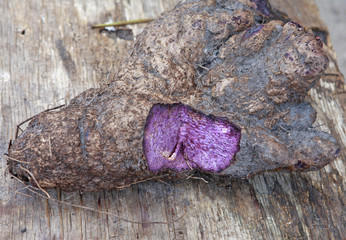

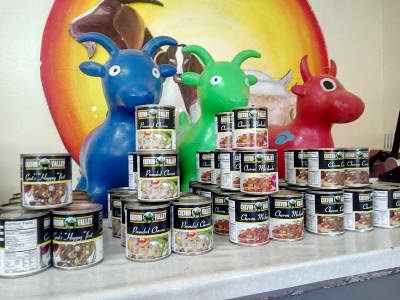 Now under its trade name, Chevon Valley, ISU-CVSRRC developed various products from chevon: canned and ready-to-eat. Among the canned chevon products include Goat’s Happy Feet, Chevon Curry, Chevon Mechado, Chili-garlic Chevon, and Pounded Chevon with filings; while the ready-to-eat products include chevon meat balls and classic dip, chevon with white sausage toppings, and chevon ribs with chestnut sauce.
“Canning was conducted to preserve the food from one year or more. By doing so, chevon products can reach market outside the country, such as Middle East wherein demand for goat is high,” said Dr. Jonathan N. Nayga, director of CVSRRC who also serves as the project leader.
Now under its trade name, Chevon Valley, ISU-CVSRRC developed various products from chevon: canned and ready-to-eat. Among the canned chevon products include Goat’s Happy Feet, Chevon Curry, Chevon Mechado, Chili-garlic Chevon, and Pounded Chevon with filings; while the ready-to-eat products include chevon meat balls and classic dip, chevon with white sausage toppings, and chevon ribs with chestnut sauce.
“Canning was conducted to preserve the food from one year or more. By doing so, chevon products can reach market outside the country, such as Middle East wherein demand for goat is high,” said Dr. Jonathan N. Nayga, director of CVSRRC who also serves as the project leader.
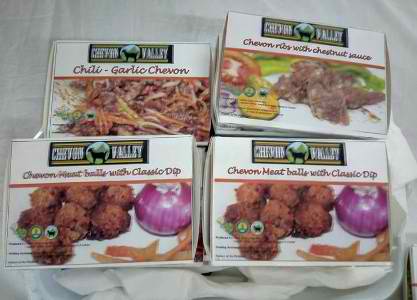 He shared that goat meat production is regarded as the principal function of goat raising among developing countries. In the Philippines, the province of Isabela as dominated by Ilokanos are known to be “goat-eating” people. And as a common practice in the past to sell goat on a per head basis, Filipinos are now introduced with the healthier option of consuming chevon among the usual red meats available in local markets such as pork and beef, and even chicken meat.
Chevon can be consumed fresh, chilled, or frozen. It has lower amount of saturated fats and has high levels of unsaturated fats as compared to other meats. Saturated fats increase the risk of acquiring cardiovascular diseases while unsaturated fats help improve blood cholesterol levels and lowering the risk having heart diseases. It has lower calories and cholesterol, and has high levels of iron and protein when compared to equal serving sizes of chicken, beef, and pork. Compared to other commercially-available canned meat, ISU’s products have no preservatives.
Seeing the potential to capture larger Filipino consumers, capturing the exquisite tastes of the local delicacies, especially those living in the urban areas and at the same time to help the goat raisers in the country, the Bureau of Agricultural Research (BAR) funded in 2014 the technology transfer of chevon product processing and commercialization of new chevon products under the National Technology Commercialization Program (NTCP).
Realizing the potential of this growing industry, Region 2 has implemented various R&D projects encompassing the whole production-to-processing cycle since 2006. Goat raising in particular is an ideal livelihood options for farmers in the rural areas since goat raising has low capital investment, and can make use of locally available forages and grasses. “Moreover, the current demand for chevon in the international market also initiates local producers to raise more,” Dr. Nayga added.
Based on the computed return of investment (ROI), all chevon products has a positive profitability with chevon meat balls having the highest ROI at 62.32 percent among the processed chevon sold at meal boxes.
He shared that goat meat production is regarded as the principal function of goat raising among developing countries. In the Philippines, the province of Isabela as dominated by Ilokanos are known to be “goat-eating” people. And as a common practice in the past to sell goat on a per head basis, Filipinos are now introduced with the healthier option of consuming chevon among the usual red meats available in local markets such as pork and beef, and even chicken meat.
Chevon can be consumed fresh, chilled, or frozen. It has lower amount of saturated fats and has high levels of unsaturated fats as compared to other meats. Saturated fats increase the risk of acquiring cardiovascular diseases while unsaturated fats help improve blood cholesterol levels and lowering the risk having heart diseases. It has lower calories and cholesterol, and has high levels of iron and protein when compared to equal serving sizes of chicken, beef, and pork. Compared to other commercially-available canned meat, ISU’s products have no preservatives.
Seeing the potential to capture larger Filipino consumers, capturing the exquisite tastes of the local delicacies, especially those living in the urban areas and at the same time to help the goat raisers in the country, the Bureau of Agricultural Research (BAR) funded in 2014 the technology transfer of chevon product processing and commercialization of new chevon products under the National Technology Commercialization Program (NTCP).
Realizing the potential of this growing industry, Region 2 has implemented various R&D projects encompassing the whole production-to-processing cycle since 2006. Goat raising in particular is an ideal livelihood options for farmers in the rural areas since goat raising has low capital investment, and can make use of locally available forages and grasses. “Moreover, the current demand for chevon in the international market also initiates local producers to raise more,” Dr. Nayga added.
Based on the computed return of investment (ROI), all chevon products has a positive profitability with chevon meat balls having the highest ROI at 62.32 percent among the processed chevon sold at meal boxes.
 The product development was made possible with the support from the Commission of Higher Education (CHED), Department of Science and Technology-Philippine Council for Agriculture, Aquatic and Natural Resources Research and Development (DOST-PCAARRD), DOST-Industrial Technology Development Institute (DOST-ITDI), Bureau of Animal Industry-Animal Products Development Center (BAI-APDC).
The ISU collaborated with Agricomponent Co., a private company, to be the exclusive franchisee of Chevon Valley. Agricomponent served as the private-partner of ISU responsible in the manufacturing and distribution of products nationwide. All products undergo proximate analysis to make products ready for commercialization. ### (Ma. Eloisa H. Aquino)
Source: bar.gov.ph
The product development was made possible with the support from the Commission of Higher Education (CHED), Department of Science and Technology-Philippine Council for Agriculture, Aquatic and Natural Resources Research and Development (DOST-PCAARRD), DOST-Industrial Technology Development Institute (DOST-ITDI), Bureau of Animal Industry-Animal Products Development Center (BAI-APDC).
The ISU collaborated with Agricomponent Co., a private company, to be the exclusive franchisee of Chevon Valley. Agricomponent served as the private-partner of ISU responsible in the manufacturing and distribution of products nationwide. All products undergo proximate analysis to make products ready for commercialization. ### (Ma. Eloisa H. Aquino)
Source: bar.gov.ph


 By no means should one consider this as an alternative to any wholesome food consumption, but it works wonders as an addition to anyone’s diet and replenishes what’s lacking. Many people have noticed
By no means should one consider this as an alternative to any wholesome food consumption, but it works wonders as an addition to anyone’s diet and replenishes what’s lacking. Many people have noticed 

 All the goodness of greens is important if you want to have a balanced diet. A lot of people associate a bitter and savoury taste with greens that would not be suitable for juice, however, with a couple of minutes prep you can turn greens into a highly pleasant drink. The green machine relies on a combination of apple, pear, celery, spinach and a bit of kale if you’ve got any. One could also add avocado if they prefer the texture of a smoothie. It’s a drink with an amicable amount of sweetness that will leave you both hydrated and fully refreshed.
All the goodness of greens is important if you want to have a balanced diet. A lot of people associate a bitter and savoury taste with greens that would not be suitable for juice, however, with a couple of minutes prep you can turn greens into a highly pleasant drink. The green machine relies on a combination of apple, pear, celery, spinach and a bit of kale if you’ve got any. One could also add avocado if they prefer the texture of a smoothie. It’s a drink with an amicable amount of sweetness that will leave you both hydrated and fully refreshed.

 Photo by
Photo by 

 Photo by kjetil_r[/caption]
Photo by kjetil_r[/caption]

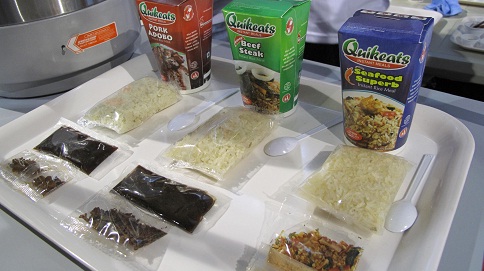 Manufactured by Five N and I Food Corporation under strict supervision of the Department of Science and Technology’s Food and Nutrition Research Institute (DOST-FNRI), Quikeats Instant Rice Meals are produced using FNRI’s dehydrated iron-fortified rice technology.
FNRI developed this iron-fortified rice technology to help address iron deficiency anemia (IDA) which is still prevalent among four out of 10 and three out of 10 pregnant and lactating women, respectively, according to DOST-FNRI’s Seventh National Nutrition Survey (7th NNS) in 2008.
IDA also affects two out of 10 children six months to five years old, as well as the six- to 12-year-olds. One out of ten 13- to 19-year-old teens are likewise affected by IDA, the survey results further revealed.
Fortifying rice with iron is a strategic nutrition intervention in helping address IDA because rice is the staple food of most Filipinos.
With this nutritional and marketing advantage, Quikeats initially unveiled the Pork Adobo Instant Rice Meal last year and eventually came-up this year with Pinoy Beef Steak and Seafood Superb variants as well.
Sporting slim and light-weight biodegradable boxes, the Quikeats Instant Meals are easily prepared by just adding hot water to rehydrate and warm the ingredients.
After ten minutes, the ingredients in pouches are mixed with the rehydrated and warm iron-fortified rice to give you your favorite instant meal on the go.
Instant Rice Meal Pork Adobo comes in a 75-gram single serving size box which packs 210 calories of energy, only 1.5 grams of total fat, 46 grams of total carbohydrates, 5 grams of total protein, 520 milligrams of sodium;
Six micrograms Retinol Equivalent (RE) of vitamin A or 1 percent of the recommended energy and nutrient intakes (RENI) for vitamin A, and 2 milligrams of iron, or 20 percent of the RENI for iron of a person 19 years old and above.
Aside from dehydrated iron-fortified rice, Instant Rice Meal Pork Adobo contains dehydrated meat, wheat protein, choice spices and condiments, modified starch, and vegetable oil.
Instant Rice Meal Pinoy Beef Steak also weighs a net 75 grams in a single serving size box which provides 220 calories of energy, 1.5 grams total fat, 46 grams total carbohydrates, 5 grams total protein, 630 milligrams sodium, 9 micrograms RE of vitamin A or 2 percent of the RENI for vitamin A, and 3 milligrams of iron, or 21 percent of the RENI for iron of a person 19 years old and above.
In addition to dehydrated iron-fortified rice, Instant Rice Meal Pinoy Beef Steak’s ingredients include dehydrated meat, wheat protein, choice spices, condiments and vegetable oil.
Instant Rice Meal Seafood Superb weighs a bit lighter at a net 60 grams single serving size box but provides comparable nutrients than the other variants at 220 calories of energy, 3 grams total fat, 47 grams total carbohydrates, 4 grams total protein, 550 milligrams sodium, 1 microgram RE of vitamin A, and 2 milligrams of iron, or 17 percent of the RENI for iron of a person 19 years old and above.
Similarly, Instant Rice Meal Seafood Superb uses dehydrated iron-fortified rice. Other ingredients include sesame oil, shrimp powder, dried seafood, dried vegetables, choice spices, condiments, and annatto powder as color enhancer.
Quikeats Instant Rice Meals are ideal for busy people who usually do not have time to prepare food or sneak out of the office or school to grab a bite to quickly satisfy that hunger in between deadlines. These are also perfect for people who travel a lot, health buffs and sports enthusiasts who go on camping, mountain climbing or any outdoor activity, and for those who simply want a quick meal to go.
Quikeats Instant Rice Meals are now available initially in selected convenience stores and supermarkets in Metro Manila, but the Five N and I Food Corporation plans to distribute to provincial outlets soon.
Suggested introductory retail price is P35.50, which is reasonable considering the nutritional value and convenient features of the product.
For inquiries on this technology, contact Dr. Mario V. Capanzana, FNRI Director, at telephone numbers: (02) 837-2934 and 839-1839 (direct lines); 837-3164 (telefax);
Manufactured by Five N and I Food Corporation under strict supervision of the Department of Science and Technology’s Food and Nutrition Research Institute (DOST-FNRI), Quikeats Instant Rice Meals are produced using FNRI’s dehydrated iron-fortified rice technology.
FNRI developed this iron-fortified rice technology to help address iron deficiency anemia (IDA) which is still prevalent among four out of 10 and three out of 10 pregnant and lactating women, respectively, according to DOST-FNRI’s Seventh National Nutrition Survey (7th NNS) in 2008.
IDA also affects two out of 10 children six months to five years old, as well as the six- to 12-year-olds. One out of ten 13- to 19-year-old teens are likewise affected by IDA, the survey results further revealed.
Fortifying rice with iron is a strategic nutrition intervention in helping address IDA because rice is the staple food of most Filipinos.
With this nutritional and marketing advantage, Quikeats initially unveiled the Pork Adobo Instant Rice Meal last year and eventually came-up this year with Pinoy Beef Steak and Seafood Superb variants as well.
Sporting slim and light-weight biodegradable boxes, the Quikeats Instant Meals are easily prepared by just adding hot water to rehydrate and warm the ingredients.
After ten minutes, the ingredients in pouches are mixed with the rehydrated and warm iron-fortified rice to give you your favorite instant meal on the go.
Instant Rice Meal Pork Adobo comes in a 75-gram single serving size box which packs 210 calories of energy, only 1.5 grams of total fat, 46 grams of total carbohydrates, 5 grams of total protein, 520 milligrams of sodium;
Six micrograms Retinol Equivalent (RE) of vitamin A or 1 percent of the recommended energy and nutrient intakes (RENI) for vitamin A, and 2 milligrams of iron, or 20 percent of the RENI for iron of a person 19 years old and above.
Aside from dehydrated iron-fortified rice, Instant Rice Meal Pork Adobo contains dehydrated meat, wheat protein, choice spices and condiments, modified starch, and vegetable oil.
Instant Rice Meal Pinoy Beef Steak also weighs a net 75 grams in a single serving size box which provides 220 calories of energy, 1.5 grams total fat, 46 grams total carbohydrates, 5 grams total protein, 630 milligrams sodium, 9 micrograms RE of vitamin A or 2 percent of the RENI for vitamin A, and 3 milligrams of iron, or 21 percent of the RENI for iron of a person 19 years old and above.
In addition to dehydrated iron-fortified rice, Instant Rice Meal Pinoy Beef Steak’s ingredients include dehydrated meat, wheat protein, choice spices, condiments and vegetable oil.
Instant Rice Meal Seafood Superb weighs a bit lighter at a net 60 grams single serving size box but provides comparable nutrients than the other variants at 220 calories of energy, 3 grams total fat, 47 grams total carbohydrates, 4 grams total protein, 550 milligrams sodium, 1 microgram RE of vitamin A, and 2 milligrams of iron, or 17 percent of the RENI for iron of a person 19 years old and above.
Similarly, Instant Rice Meal Seafood Superb uses dehydrated iron-fortified rice. Other ingredients include sesame oil, shrimp powder, dried seafood, dried vegetables, choice spices, condiments, and annatto powder as color enhancer.
Quikeats Instant Rice Meals are ideal for busy people who usually do not have time to prepare food or sneak out of the office or school to grab a bite to quickly satisfy that hunger in between deadlines. These are also perfect for people who travel a lot, health buffs and sports enthusiasts who go on camping, mountain climbing or any outdoor activity, and for those who simply want a quick meal to go.
Quikeats Instant Rice Meals are now available initially in selected convenience stores and supermarkets in Metro Manila, but the Five N and I Food Corporation plans to distribute to provincial outlets soon.
Suggested introductory retail price is P35.50, which is reasonable considering the nutritional value and convenient features of the product.
For inquiries on this technology, contact Dr. Mario V. Capanzana, FNRI Director, at telephone numbers: (02) 837-2934 and 839-1839 (direct lines); 837-3164 (telefax); 
 Ingredients
100 grams butter
100 grams lemon juice
100 grams granulated sugar
2 pieces egg
5 pieces tart shells
Procedure
1. Combine butter, lemon juice and sugar in a sauce pan. Boil.
2. In a bowl, whisk in eggs. Add a third of the boiling liquid and whisk. Add remaining hot mixture and return to fire. Cook until thick.
3. Pour over tart shells and chill.
Ingredients
100 grams butter
100 grams lemon juice
100 grams granulated sugar
2 pieces egg
5 pieces tart shells
Procedure
1. Combine butter, lemon juice and sugar in a sauce pan. Boil.
2. In a bowl, whisk in eggs. Add a third of the boiling liquid and whisk. Add remaining hot mixture and return to fire. Cook until thick.
3. Pour over tart shells and chill.

 1/2 cup mayonnaise
2 tablespoons ketchup
1 tablespoon white vinegar
2 teaspoons sugar
2 teaspoons sweet pickle relish
1 teaspoon finely minced white onion
1/8 teaspoon salt
dash of black pepper
1. Combine all of the ingredients in a small bowl. Stir well.
2. Place dressing in a covered container and refrigerate for several hours, stirring occasionally, so that the sugar dissolves and the flavors blend.
Makes about 3/4 cup.
1/2 cup mayonnaise
2 tablespoons ketchup
1 tablespoon white vinegar
2 teaspoons sugar
2 teaspoons sweet pickle relish
1 teaspoon finely minced white onion
1/8 teaspoon salt
dash of black pepper
1. Combine all of the ingredients in a small bowl. Stir well.
2. Place dressing in a covered container and refrigerate for several hours, stirring occasionally, so that the sugar dissolves and the flavors blend.
Makes about 3/4 cup.

 Materials:
Coconut water
Refined sugar
Ammonium phosphate
Acetic acid
Nata starter
Equipments:
Weighing scale
Wide-mouthed glass jars or basins
Strainers
Kettles
Procedure:
1. The collected coconut water is filtered through a cheesecloth. One hundred (100 gms) refined sugar and 5 grams monobasic ammonium phosphate is mixed for every liter of coconut water in a container. The container is covered and the mixture allowed to boil. It is then allowed to cool after boiling and 6 9 ml of glacial acetic acid is added.
2. 110-150 ml of starter (available at ITDI) is added to the mixture. It is subsequently transferred to big mouthed clean jars leaving ample space atop mixture and covered with clean cheese cloth. The culture is allowed to grow at room temperature for 15 days or more. Note: Do not move jars during growth period.
3. Harvest is ready after 15 days or more, making sure that all conditions are aseptic so as to enable one to reuse the remaining liquid which serves as starter for succeeding preparations.
4. Dessert Making. The "nata" is cut into cubes and is subjected to a series of boiling with fresh water until acidity is totally removed. One kilo of refined sugar is added for every kilo of nata and are mixed. It is brought to boiling until the "nata" cubes become transparent.
Sources: ITDI (DOST), coconutboard.nic.in/nata.htm
Materials:
Coconut water
Refined sugar
Ammonium phosphate
Acetic acid
Nata starter
Equipments:
Weighing scale
Wide-mouthed glass jars or basins
Strainers
Kettles
Procedure:
1. The collected coconut water is filtered through a cheesecloth. One hundred (100 gms) refined sugar and 5 grams monobasic ammonium phosphate is mixed for every liter of coconut water in a container. The container is covered and the mixture allowed to boil. It is then allowed to cool after boiling and 6 9 ml of glacial acetic acid is added.
2. 110-150 ml of starter (available at ITDI) is added to the mixture. It is subsequently transferred to big mouthed clean jars leaving ample space atop mixture and covered with clean cheese cloth. The culture is allowed to grow at room temperature for 15 days or more. Note: Do not move jars during growth period.
3. Harvest is ready after 15 days or more, making sure that all conditions are aseptic so as to enable one to reuse the remaining liquid which serves as starter for succeeding preparations.
4. Dessert Making. The "nata" is cut into cubes and is subjected to a series of boiling with fresh water until acidity is totally removed. One kilo of refined sugar is added for every kilo of nata and are mixed. It is brought to boiling until the "nata" cubes become transparent.
Sources: ITDI (DOST), coconutboard.nic.in/nata.htm

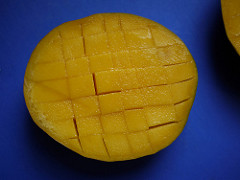 Photo by
Photo by 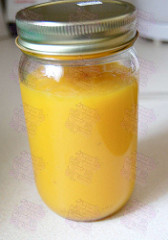 Photo by purplevintagespaceprincess[/caption]
Photo by purplevintagespaceprincess[/caption]
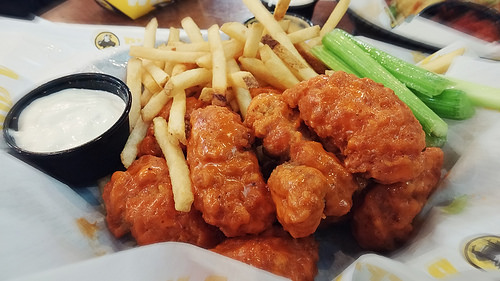 Photo by
Photo by 
 Canned Rellenong Bangus
(Palomares et al, 1978)
Ingredients
700 grams Bangus
90 grams Tomatoes
15 grams Garlic
80 grams Onions
75 grams Red bell pepper
75 grams Cooked green peas
28 grams Raisins
70 ml Corn oil for sautéing
7 grams Salt
75 grams Sweet pickles
3 grams Monosodium Glutamate (MSG)
Kalamansi juice and soy sauce mixture (1:2) (enough to cover fish skin)
Procedure:
1. Scale and eviscerate the fresh fish and then wash thoroughly to remove the blood and other foreign matter.
Drain.
2. Separate the flesh from the skin and debone the meat. Marinate skin into a mixture of kalamansi juice and
soy sauce (1:2).
2. Sauté garlic, onion and tomatoes in oil. Add the minced meat, peas, red pepper, pickles, raisin, salt and MSG.
4. Stuff the sautéed mixture into the skin. Freeze.
5. Cut the frozen stuffed fish transversely into can sizes.
6. Pack in can (307 x 201.25 size) at 170-180 g/can. Add enough corn oil: water mixture (1:1) leaving 0.42 (1/6 inch) headspace.
7. Exhaust into an internal temperature of 82.2ºC (180ºF). Seal cans completely and process.
Canned Rellenong Bangus
(Palomares et al, 1978)
Ingredients
700 grams Bangus
90 grams Tomatoes
15 grams Garlic
80 grams Onions
75 grams Red bell pepper
75 grams Cooked green peas
28 grams Raisins
70 ml Corn oil for sautéing
7 grams Salt
75 grams Sweet pickles
3 grams Monosodium Glutamate (MSG)
Kalamansi juice and soy sauce mixture (1:2) (enough to cover fish skin)
Procedure:
1. Scale and eviscerate the fresh fish and then wash thoroughly to remove the blood and other foreign matter.
Drain.
2. Separate the flesh from the skin and debone the meat. Marinate skin into a mixture of kalamansi juice and
soy sauce (1:2).
2. Sauté garlic, onion and tomatoes in oil. Add the minced meat, peas, red pepper, pickles, raisin, salt and MSG.
4. Stuff the sautéed mixture into the skin. Freeze.
5. Cut the frozen stuffed fish transversely into can sizes.
6. Pack in can (307 x 201.25 size) at 170-180 g/can. Add enough corn oil: water mixture (1:1) leaving 0.42 (1/6 inch) headspace.
7. Exhaust into an internal temperature of 82.2ºC (180ºF). Seal cans completely and process.
 Source: (Wilfredo G. Yap, Antonio C. Villaluz, Ma. Gracia G. Soriano, and Mary Nia Santos) Milkfish Production and Processing Technologies in the Philippines
Source: (Wilfredo G. Yap, Antonio C. Villaluz, Ma. Gracia G. Soriano, and Mary Nia Santos) Milkfish Production and Processing Technologies in the Philippines

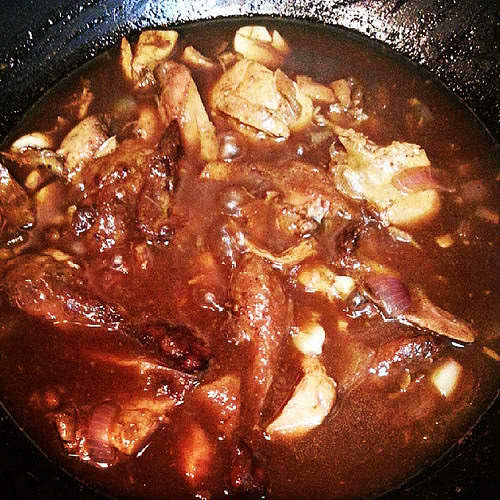 Lechon Paksiw
Ingredients
Lechon Paksiw
Ingredients

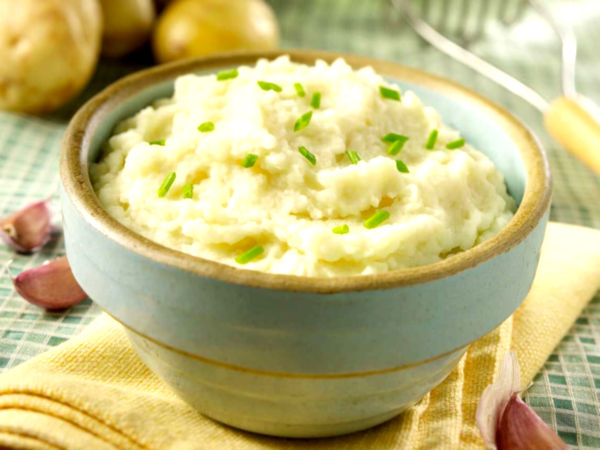 Chevys® Garlic Mashed Potatoes
This easy-to-clone dish comes with many of the tasty entrees at the restaurant chain or can be ordered up, pronto, on the side. It's a nice clone to have around since it goes well with so many dishes, Mexican or otherwise. Just give yourself the time to bake and cool the potatoes.
4 medium/large russet potatoes
1 tablespoon butter
1 tablespoon minced fresh garlic (3-4 cloves)
3/4 cup water
1/2 cup cream
3/4 teaspoon salt
1/8 teaspoon black pepper
1. Preheat oven to 400 degrees.
2. Bake the potatoes by first rubbing them lightly with oil and then baking them in the preheated oven for 1 hour until they are tender. Cool.
3. Mash potatoes and remove about half of the skin. You want to leave the rest in.
4. Melt the butter in a large suacepan over medium heat, then add garlic and saute for 5 minutes.
5. Add the remaining ingredients to the pan and cook for 5-10 minutes while stirring often until garlic mashed potatoes are very hot.
Serves 4.
Chevys® Garlic Mashed Potatoes
This easy-to-clone dish comes with many of the tasty entrees at the restaurant chain or can be ordered up, pronto, on the side. It's a nice clone to have around since it goes well with so many dishes, Mexican or otherwise. Just give yourself the time to bake and cool the potatoes.
4 medium/large russet potatoes
1 tablespoon butter
1 tablespoon minced fresh garlic (3-4 cloves)
3/4 cup water
1/2 cup cream
3/4 teaspoon salt
1/8 teaspoon black pepper
1. Preheat oven to 400 degrees.
2. Bake the potatoes by first rubbing them lightly with oil and then baking them in the preheated oven for 1 hour until they are tender. Cool.
3. Mash potatoes and remove about half of the skin. You want to leave the rest in.
4. Melt the butter in a large suacepan over medium heat, then add garlic and saute for 5 minutes.
5. Add the remaining ingredients to the pan and cook for 5-10 minutes while stirring often until garlic mashed potatoes are very hot.
Serves 4.

 Photo by
Photo by 
 Materials:
1 kilo (5 cups) mashed ripe bananas (saba or cavendish)
300 gm. (2 1/4 cups) sugar
Butter or margarine
Utensils needed:
Rolling pin
Frying pan
Chopping or kneading board
Spatula
Kitchen knife
Wax paper
Procedure:
1. Prepare the mashed bananas as follows: Boil the ripe bananas (saba or cavendish). Peel and slice into 3 cm. thick
2. Grind the sliced bananas until it is mashed, add the sugar and cook over slow fire. Stirring should be done constantly until a clear mixture is obtained with the desired consistency. The mixture should not stick to the sides of the frying pan
3. Transfer the mixture over a kneading board covered with wax paper. Sprinkle small amounts of sugar over the wax paper. Spread the mashed mixture using a rolling pin until it is 1 inch thick.
4. Spread butter and small amounts of sugar over the mixture
5. Make slices of about 4 x 1 cm. Cool and wrap individually
Source: Food and Technology Research and Development Program ITDI, DOST
Materials:
1 kilo (5 cups) mashed ripe bananas (saba or cavendish)
300 gm. (2 1/4 cups) sugar
Butter or margarine
Utensils needed:
Rolling pin
Frying pan
Chopping or kneading board
Spatula
Kitchen knife
Wax paper
Procedure:
1. Prepare the mashed bananas as follows: Boil the ripe bananas (saba or cavendish). Peel and slice into 3 cm. thick
2. Grind the sliced bananas until it is mashed, add the sugar and cook over slow fire. Stirring should be done constantly until a clear mixture is obtained with the desired consistency. The mixture should not stick to the sides of the frying pan
3. Transfer the mixture over a kneading board covered with wax paper. Sprinkle small amounts of sugar over the wax paper. Spread the mashed mixture using a rolling pin until it is 1 inch thick.
4. Spread butter and small amounts of sugar over the mixture
5. Make slices of about 4 x 1 cm. Cool and wrap individually
Source: Food and Technology Research and Development Program ITDI, DOST

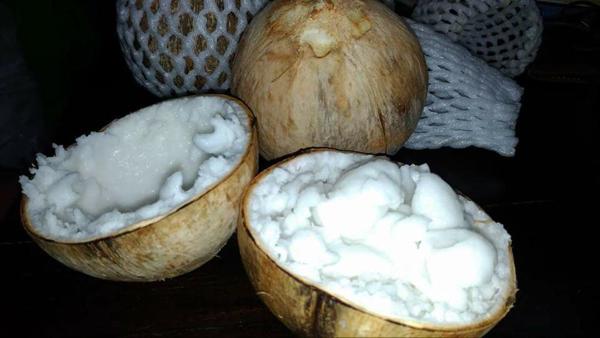 Ingredients:
Maraschino cherries
2 tablespoon butter
1 macapuno, mashed
1 cup fresh milk
Sugar to taste
1/4 cup casuy nuts
1/4 cup egg yolks
Procedure:
1. Add milk to mashed macapuno and cook over low heat until most of the milk has evaporated.
2. Add sugar to taste and casuy.
3. Remove from fire, add lightly beaten yolks and butter and mix well to avoid curdling.
4. Continue cooking over low heat, stirring constantly, until the mixture can be shaped into balls.
5. Remove from fire, cool, shape into balls the size of a small calamansi.
6. Brush with beaten egg yolk, top with thin slices of cherries and bake on buttered cookie sheet in moderate oven until brown.
Ingredients:
Maraschino cherries
2 tablespoon butter
1 macapuno, mashed
1 cup fresh milk
Sugar to taste
1/4 cup casuy nuts
1/4 cup egg yolks
Procedure:
1. Add milk to mashed macapuno and cook over low heat until most of the milk has evaporated.
2. Add sugar to taste and casuy.
3. Remove from fire, add lightly beaten yolks and butter and mix well to avoid curdling.
4. Continue cooking over low heat, stirring constantly, until the mixture can be shaped into balls.
5. Remove from fire, cool, shape into balls the size of a small calamansi.
6. Brush with beaten egg yolk, top with thin slices of cherries and bake on buttered cookie sheet in moderate oven until brown.